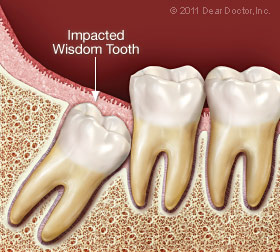Dentistry & Oral Health For Children
Guiding your child's oral health from birth through adolescence
(Continued)
Trauma Comes In Many Forms
Missing teeth and trauma to teeth are common problems of childhood and adolescence. Congenitally missing teeth (“con” – together with; “genital” – birth) are not infrequent especially in the upper lateral incisor position (the ones right next to the upper front teeth). Teeth lost to advanced decay or trauma also present problems. The baby teeth act as guides for the permanent successors, and when they are lost, movement of the remaining teeth into their spaces disrupts this function. If the spaces are not maintained with retainer-like appliances, it is almost assured that malocclusion will result.
Losing teeth has a great effect on the remaining bone. See our consultation on tooth removal for orthodontic reasons. More information is provided on innovative surgical techniques in use today for bone conservation and regeneration, and to prevent recession of gum tissues following orthodontics.
Did you know that the most common injury in children and adolescents is trauma to upper front teeth? In our last special issue on “Sports Injuries and Dentistry,” we covered many aspects of what to do, when to do it, and who should carry out treatment. We also published a field-side guide for treatment of dental injuries, and how to prevent them in the form of custom-made mouthguards.
Many dental injuries resulting in chips and minor fractures to front teeth can be temporarily fixed with today's tooth-colored restorative bonding materials. They perform an excellent service until the individual has completed facial growth, changed lifestyle and is no longer as vulnerable to dental injury. Then more permanent restorations can be placed, such as porcelain veneers or crowns.
For more severe injuries that have resulted in tooth loss, and for permanent replacement of missing teeth, dental implants are the state-of-the-art tooth replacement systems, provided growth of the face and jaws is complete. Modern dental implants have revolutionized dentistry; they stabilize bone, and can also be used to facilitate orthodontic tooth movement in the form of Temporary Anchorage Devices (TADs).
 |
| Impacted wisdom teeth, trapped in poor positions, can cause damage to neighboring healthy teeth, bone and gum tissue in addition to other vital structures such as blood vessels and nerves. |
Does It End With Wisdom Teeth?
Perhaps in the end, it is with the emergence of the wisdom teeth that maturity is finally signified. Wisdom teeth appear between ages 17 and 25. Their name, interestingly, is associated with a final coming of age across cultures — the attainment of a certain (if not romanticized) wisdom. Strangely enough, modern science has recently confirmed that this is the age when the brain reaches maturity.
But does it end with wisdom teeth? Alas not, for while wisdom teeth may signify the true end of childhood and adolescence, they also usher in the hopefully long era of adulthood, and, like adulthood, wisdom teeth come with their own set of problems. Impacted wisdom teeth, trapped in poor positions, can cause damage to neighboring healthy teeth, bone and gum tissue in addition to other vital structures such as blood vessels and nerves. Early detection of problems and their early removal, before roots form, can definitely be “a stitch in time.”
And In The End
And in the end, this whirlwind overview of oral health and dentistry for children is really just a beginning and a guide, to what will hopefully set your child on the best road, not only to lifelong oral health, but also to general and emotional health — and well-being.

